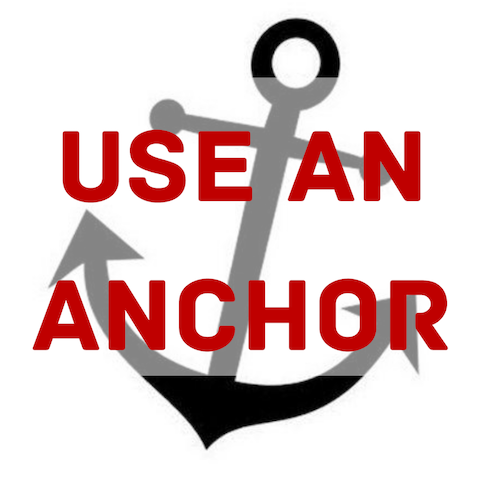Anchoring
I thought anchoring had to do with boating, how does this have to do with negotiation?
According to Wikipedia, “Anchoring is a cognitive bias where an individual depends too heavily on an initial piece of information offered to make subsequent judgments during decision making. Once the value of this anchor is set, all future negotiations, arguments, estimates, etc. are discussed in relation to the anchor.”
Do you see how this can be useful in a negotiation? In any negotiation, both you and your counterpart will be anchored to the first value given. I’ll give one brief example of your counterpart giving a high anchor, and how to respond, as well as an example of your counterpart giving a low anchor.

Example 1:
Pretend you are at a street market and you want to buy a t-shirt. The vendor says that the shirt costs $40. That is the initial anchor that you will be mentally tied to. In response, you will need to give a low anchor that they will be tied to. Pretend you want to pay no more than $25 for the shirt. You can tell the vendor that you want to pay $10 for the shirt. The vendor may then counter with $35, you counter with $20, then they counter back to $30, and you say $25. They may counter again, or agree to sell it at $25. If they counter, you can choose to raise your price a couple of dollars, or stick to $25. After you give your low anchor you raise the value by decreasing increments until you hit your maximum.
If the vendor's minimum is still below your maximum, you don’t purchase the item. What gives you the power in this type of negotiation is that you don't need the t-shirt. If you speak like you’re desperate to purchase it, you won’t be able to use an anchor effectively. If you act like you don’t care if you end up with the t-shirt or not, you’re more likely to end up with it. You have to be ready to walk away empty handed. The “worst outcome” in this situation is that you leave the vendor without your t-shirt. In that case, you’re no worse off than you were before.
Accepting the possibility of walking away empty handed will give you more confidence and more leverage going into a negotiation. If you are not okay to walk away empty handed, you’re much more likely to negotiate against yourself, or begin with a higher anchor to begin with. You’re more likely to purchase the item at a much higher price if you think that you need to buy it.
Example 2:
Pretend you just received a job offer, and the company is offering you $100,000. This may sound like a lot, but it’s actually a low anchor for your company. Companies typically offer the bottom level of what they have budgeted for the role because they build in a buffer for negotiation. Now, pretend you actually want $110,000. You can’t ask for $110,000, because the company will likely not give you the full extra $10k. Maybe you’d only get 5k. Instead, you ask for $115,000. This is your high anchor. You’re asking for more than what you would be happy with so when the company counters, they counter with the number you wanted in the first place. When the company counters (likely with a $110k or $108k offer), you can accept.

You can give a high anchor in many other scenarios: freelancing, babysitting, and selling artwork are just a few examples. The opportunities are endless. If you hear someone wants to hire you as a videographer for an event and pay you $15 per hour, feel free to ask for $20 per hour, or whatever you think you deserve. If they agree to $20, great. Otherwise, you may get $18 per hour.
When negotiating for an amount of money that you want, your ask should always be more than you would be happy with. Your negotiation counterpart will likely counter with less, which you’re much more likely to be happy with if you lead with a high anchor. If they agree to your first number, then you’ve come away with a surplus!

Why is anchoring important? Well, most obviously, it helps you save money, or earn more money. What if you offered $25 for the t-shirt and did not budge until the vendor sold it to you. What if you asked for $110,000 immediately and didn’t settle for anything less? When an anchor is given and there is back and forth from two parties before arriving at a final value, both parties actually come away from the encounter with more positive feelings than if no negotiation occurs. Even if the end result is the same, the anchoring and haggling actually makes each side feel like they have influenced the outcome.
Your counterpart is not your enemy in a negotiation. This distinction is very important. You may be at opposite ends of the table, but you are looking for a solution that will be mutually beneficial. Ending a negotiation with not only a positive outcome, but a positive outlook on the exchange, is more beneficial than only getting the desired outcome.